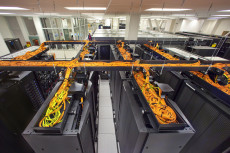Ten Projects Awarded NERSC Allocations under DOE’s ALCC Program
June 24, 2014
Under the Department of Energy’s (DOE) ASCR Leadership Computing Challenge (ALCC) program, 10 research teams at national laboratories and universities have been awarded 382.5 million hours of computing time at the National Energy Research Scientific Computing Center (NERSC). The ALCC, managed by DOE’s Advanced Scientific Computing Research (ASCR) awards time to researchers to pursue “high-risk, high-payoff” simulation research in energy-mission areas and national emergency mitigation.
In addition to supporting projects of interest to DOE, the ALCC program also aims to broaden the community of researchers capable of using leadership computing resources. In addition to NERSC, allocations are also awarded for supercomputers at Argonne and Oak Ridge national labs. NERSC, managed by Lawrence Berkeley National Laboratory, is the DOE Office of Science’s primary supercomputing center for science, supporting more than 5,000 users at universities, national labs and other research organizations,
ALCC awards support scientific and technological research in bioenergy, energy efficiency, turbomachinery design, fusion energy, high energy physics, materials science, nuclear physics, nuclear reactor safety, climate modeling and seismology. The following proposals received ALCC allocations at NERSC:
- Ron Brightwell from Sandia National Laboratories received 40 million processor hours, of which 5 million are at NERSC, for “Hobbes: Operating System and Runtime Research for Extreme Scale.”
- D.R. Ernst from MIT received 30 million processor hours for “Gyrokinetic Simulations of the Effect of Electron Heating on Particle and Electron Thermal Energy Transport in Magnetic Fusion Plasmas.”
- Benjamin Gaddy from North Carolina State University received 7 million processor hours for “Controlling Conductivity in High-Al content AlGaN by Understanding Defect Formation Energies via DFT.”
- Aytekin Gel from ALPEMI received 37.5 million processor hours for “Uncertainty Quantification in Coal Gasifier Simulations for Clean Energy Technology Development and Production.”
- Salman Habib from Argonne National Laboratory received 176 million processor hours, of which 76 million are at NERSC, for “Cosmic Frontier Computational End-Station.”
- Christopher Holland from the University of California, San Diego, received 140 million processor hours, of which 50 million are at NERSC, for “Validation Studies of Gyrokinetic Simulations to Understand the Coupling of Ion and Electron Scale Turbulence in Tokamak Plasmas.”
- Thomas LeCompte from Argonne National Laboratory received 52,000,000 processor hours, of which 2 million are at NERSC, for “Simulation of Large Hadron Collider Events Using Leadership Computing.”
- Noa Marom from Tulane University received 105 million processor hours, of which 30 million are at NERSC, for “Interfaces in Organic and Hybrid Photovoltaics.”
- Barbara Romanowicz from the University of California, Berkley, received 6 million processor hours for “Application of Numerical Time-reversal Mirror for the Construction of Continental Scale Tomographic Model of the Upper Mantle Based on Full Waveform Seismic Inversion.”
- Klaus Schulten from University of Illinois at Urbana-Champaign received 69 million processor hours for “Molecular Dynamics Studies of Biomass Degradation in Biofuel Production.”
- David Trebotich from Lawrence Berkeley National Laboratory received 100 million processor hours, of which 50 million are at NERSC, for “Chombo-Crunch: Modeling Pore Scale Reactive Transport Processes Associated with Carbon Sequestration.”
- John Turner from ORNL received 100 million processor hours, of which 20 million are at NERSC, for “Delivering Advanced Modeling & Simulation for Nuclear Energy Applications.”
About NERSC and Berkeley Lab
The National Energy Research Scientific Computing Center (NERSC) is a U.S. Department of Energy Office of Science User Facility that serves as the primary high performance computing center for scientific research sponsored by the Office of Science. Located at Lawrence Berkeley National Laboratory, NERSC serves almost 10,000 scientists at national laboratories and universities researching a wide range of problems in climate, fusion energy, materials science, physics, chemistry, computational biology, and other disciplines. Berkeley Lab is a DOE national laboratory located in Berkeley, California. It conducts unclassified scientific research and is managed by the University of California for the U.S. Department of Energy. »Learn more about computing sciences at Berkeley Lab.








